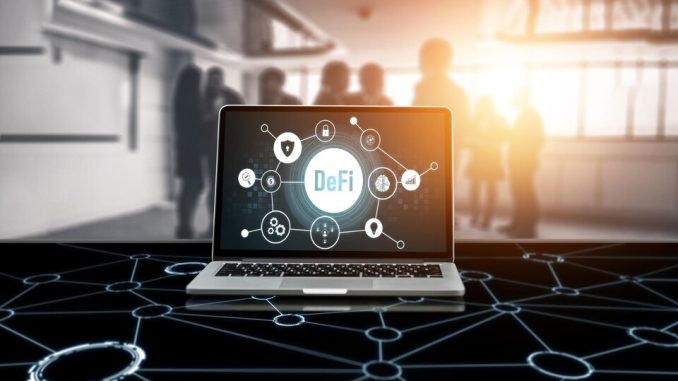
Automated Market Makers (AMMs) are leading the decentralized finance (DeFi) revolution, transforming digital asset trading and management. This article discusses AMMs’ benefits, protocols, use cases, problems, and future in the DeFi ecosystem. Smart contract systems have made financial markets more accessible and transparent, allowing people worldwide to contribute to liquidity pools and easily trade tokens in DeFi. AMMs provide many advantages but also hazards and obstacles, underlining the need for responsible involvement. AMMs will shape finance for years as DeFi evolves.
How AMMs Work
Automated Market Makers (AMMs) are an essential decentralized financial innovation. These smart contract systems automate decentralized digital asset exchange. Liquidity pools enable token trading without order books in AMMs. Users deposit pairs of assets into AMM liquidity pools. Pools may hold ETH and DAI coins. Smart contracts determine asset prices using a basic supply-and-demand formula.
The pool’s ratios alter automatically as tokens are traded. Automation reduces order matching and middlemen, making trading more efficient and user-friendly. AMMs enable 24/7 trading, which is beneficial in the volatile crypto market. Users earn fees by donating assets to these pools as liquidity providers. AMMs are accessible and let more people trade decentralized without centralized exchanges in DeFi.
Advantages Of AMMs
AMMs’ popularity in DeFi is due to their many benefits. Democratizing finance is a significant benefit. Bankless people are typically excluded from traditional financial systems. AMMs allow everyone with an internet connection to engage in the global financial ecosystem. Only a suitable wallet is needed.
AMMs boost DeFi liquidity. Users assist smooth trading by contributing assets to liquidity pools. Based on their contributions, liquidity providers get fees and benefits. This has increased yield farming and liquidity mining, where users optimize assets to maximum profits.
Blockchain technology promotes transparency and decentralization, which AMMs support. The blockchain records all AMM transactions, making them transparent and immutable. AMMs are open-source and auditable, building user confidence over closed financial systems.
Key Amm Protocols
Several necessary AMM protocols shape DeFi. Pioneer Uniswap is noted for its simple design and usability. With several token pairings, it’s popular with traders. Many AMM methods followed Uniswap’s success. A balancer is another major AMM player. Balancer’s portfolio allocation flexibility is unique. Users may establish or join token pools with different weights. This encourages varied investment methods and attracts liquidity providers wanting portfolio control.
Stablecoin trading is Curve Finance’s specialty. For stablecoins and other stable assets, its AMM pools provide minimal slippage swaps. Traders and yield farmers who seek to retain asset value while engaging in DeFi activities benefit from this. Users may choose from primary platforms like Uniswap to advanced portfolio management and stablecoin trading on Balancer and Curve Finance. Each protocol meets distinct DeFi ecosystem demands, boosting development and innovation.
AMMs And Defi Use Cases
Decentralized trading, liquidity provision, and token swaps with minimum slippage rely on Automated Market Makers (AMMs). Decentralized exchanges are a significant use case for AMMs. AMM-powered DEXs allow consumers to exchange several cryptocurrencies securely and without custody. Accessibility, openness, and efficiency make these transactions appealing.
AMMs are also used for liquidity and yield farming. Depositing assets into AMM liquidity pools makes users liquidity providers. They get fees and perks for participating. Yield farming optimizes profits by systematically assigning assets to pools, frequently on separate DeFi platforms. This passive income method is popular in DeFi.
AMMs revolve around token swaps. AMMs enable Bitcoin exchanges with minimum slippage. This is useful for traders who need to make accurate trades or convert assets without affecting prices. AMMs allow DeFi customers to do a variety of financial transactions without financial intermediaries due to their flexibility and efficiency.
Challenges And Risks
Despite their benefits, AMMs have drawbacks. AMM liquidity provision concerns include “impermanent loss.” The value of liquidity pool assets deviates dramatically from their original contribution. When prices vary, liquidity providers may lose more than asset holders. Smart contract vulnerabilities are another issue. AMMs trade and manage liquidity pools using smart contracts. An intelligent contract vulnerability or bad actor attack might put users’ cash at risk.
Security and regulatory issues pose dangers. DeFi regulation is new and needs to be clarified in many areas. Users and platforms may face legal issues due to this ambiguity. DeFi systems have also been hacked, causing users huge losses. Users participating in DeFi operations using AMM must address these problems and mitigate hazards. Understanding the dangers and using recommended practices may help users avoid these issues.
The Future Of AMMs In Defi
Automated Market Makers (AMMs) in decentralized finance (DeFi) will innovate and grow. These platforms have revolutionized digital asset trading and management, but their potential still needs to be tapped. The future of DeFi AMM includes protocol upgrades. Developers are ceaselessly improving AMM platform efficiency and usefulness. This includes algorithm optimization, gas charge reduction, and user experience improvement. These enhancements will make DeFi easier to use, promoting adoption.
Exciting developments include integration with conventional finance. As DeFi protocols, particularly AMMs, gain popularity and robustness, they are interacting with existing financial systems. This connectivity might enable customers to smoothly shift assets between centralized and decentralized economic systems.
In the DeFi environment, AMMs are also changing. They are essential to new financial products and services beyond trading and liquidity. AMMs provide new financial instruments and investment options, giving users more ways to build and manage their assets. As DeFi grows and gains respect in the financial sector, AMMs will be crucial to this shift. Their flexibility, openness, and efficiency drive decentralized finance’s progress.
Conclusion
Automation Market Makers (AMMs) are a significant force in decentralized finance. These automated trading systems have transformed digital asset exchange and management, providing worldwide accessibility, transparency, and efficiency. Smart contracts, algorithmic trading, and liquidity provision underpin AMMs. They let users contribute assets to liquidity pools, facilitate token exchanges, and earn fees and incentives in the DeFi ecosystem. AMMs have several benefits, but impermanent loss, smart contract weaknesses, and regulatory issues are drawbacks. DeFi users must be cautious and aware of the threats.






Leave a Reply